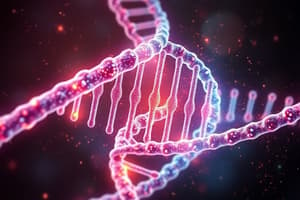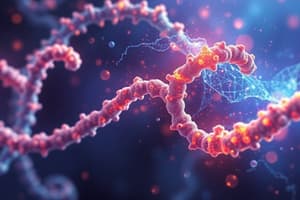Podcast
Questions and Answers
What happens during the process of translation?
What happens during the process of translation?
- Messenger RNA is made from DNA
- Copies of DNA molecules are made
- Transfer RNA is made from messenger RNA
- The cell uses information from messenger RNA to produce proteins (correct)
Genes contain instructions for assembling...
Genes contain instructions for assembling...
- Nucleosomes
- Proteins (correct)
- Purines
- Pyrimidines
Which of the following are found in both DNA and RNA?
Which of the following are found in both DNA and RNA?
- Ribose, phosphate groups, and adenine
- Deoxyribose, phosphate groups, and guanine
- Phosphate groups, guanine, and thymine
- Phosphate groups, guanine and cytosine (correct)
Transcription proceeds when RNA polymerase...
Transcription proceeds when RNA polymerase...
During transcription, an RNA molecule is formed...
During transcription, an RNA molecule is formed...
The function of RNA is to...
The function of RNA is to...
During transcription, the genetic information for making a protein is rewritten as a molecule of...
During transcription, the genetic information for making a protein is rewritten as a molecule of...
Each nucleotide triplet in mRNA that specifies a particular amino acid is called an...
Each nucleotide triplet in mRNA that specifies a particular amino acid is called an...
The portions of DNA molecules that actually code for the production of proteins are called...
The portions of DNA molecules that actually code for the production of proteins are called...
Transfer RNA...
Transfer RNA...
Griffith's experiments showed that...
Griffith's experiments showed that...
The rungs of the DNA 'ladder' consist of...
The rungs of the DNA 'ladder' consist of...
The scientists credited with establishing the structure of DNA are...
The scientists credited with establishing the structure of DNA are...
Molecules of DNA are composed of long chains of...
Molecules of DNA are composed of long chains of...
The part of the molecule for which deoxyribonucleic acid is named is the...
The part of the molecule for which deoxyribonucleic acid is named is the...
The two strands of DNA joined by base pairs are called...
The two strands of DNA joined by base pairs are called...
The base pairs of DNA are held together by...
The base pairs of DNA are held together by...
In RNA, adenine is paired with...
In RNA, adenine is paired with...
List the three types of RNA.
List the three types of RNA.
Three specific bases in a sequence are known as a...
Three specific bases in a sequence are known as a...
Where does transcription occur?
Where does transcription occur?
Where does translation occur?
Where does translation occur?
How many codons are there?
How many codons are there?
How many amino acids are there?
How many amino acids are there?
Which RNA is folded?
Which RNA is folded?
What type of RNA rewrites information from DNA?
What type of RNA rewrites information from DNA?
Duplicating DNA is called...
Duplicating DNA is called...
RNA's job ultimately is to make what?
RNA's job ultimately is to make what?
Where is DNA located in eukaryotes?
Where is DNA located in eukaryotes?
Which sugar is in RNA?
Which sugar is in RNA?
Which base is in RNA but not DNA?
Which base is in RNA but not DNA?
Transcription makes what type of RNA?
Transcription makes what type of RNA?
Genes contain instructions for making...
Genes contain instructions for making...
DNA is made up of long chains of?
DNA is made up of long chains of?
What bases are purines?
What bases are purines?
What bases are pyrimidines?
What bases are pyrimidines?
Type of RNA that acts as a template to make proteins?
Type of RNA that acts as a template to make proteins?
Type of RNA that carries the amino acid and decodes the mRNA?
Type of RNA that carries the amino acid and decodes the mRNA?
Type of RNA that makes a ribosome?
Type of RNA that makes a ribosome?
Flashcards are hidden until you start studying
Study Notes
Translation Process
- Translation involves the use of messenger RNA (mRNA) to synthesize proteins within the cell.
- It is essential for the genetic code contained in mRNA to be translated into a sequence of amino acids.
Genes and Protein Assembly
- Genes provide the necessary instructions for assembling proteins.
- Proteins are crucial macromolecules that play a variety of functional roles in organisms.
Common Components of DNA and RNA
- Both DNA and RNA share phosphate groups, guanine, and cytosine as common components.
- This commonality highlights the structural similarities between both nucleic acids.
Role of RNA Polymerase
- RNA polymerase initiates transcription by binding to the promoter region of a gene on DNA.
- This binding is a critical step in the process of synthesizing RNA from the DNA template.
Transcription Details
- RNA synthesis occurs specifically in the nucleus of eukaryotic cells.
- The RNA molecule formed is complementary to the DNA template strand and serves various functions in the cell.
Functions of RNA
- RNA has multiple roles, including forming ribosomes and carrying amino acids.
- Messenger RNA (mRNA) serves to convey genetic information for protein synthesis.
Codons and Exons
- A codon consists of a three-nucleotide sequence in mRNA that specifies a particular amino acid.
- Exons are portions of DNA that contain the coding sequences necessary for protein production.
Transfer RNA (tRNA)
- tRNA transports amino acids to the ribosome, matching them with their corresponding codons on the mRNA.
- This function is essential for accurate protein synthesis.
Griffith's Experiment
- Griffith's experiments demonstrated that genetic material can be transferred from dead bacteria to living ones, leading to transformation.
Structure of DNA
- The DNA molecule consists of two complementary strands held together by hydrogen bonds between base pairs.
- The rungs of the DNA "ladder" are formed by these base pairs, specifically adenine (A) with thymine (T) and guanine (G) with cytosine (C).
Discovery of DNA Structure
- James Watson and Francis Crick are credited with elucidating the double-helix structure of DNA, foundational for understanding genetics.
Composition of DNA
- DNA is made up of long chains of nucleotides, which each consist of a sugar, phosphate group, and nitrogenous base.
- The sugar component of DNA is deoxyribose, while ribose is found in RNA.
RNA Types and Functions
- There are three primary types of RNA:
- mRNA (messenger RNA) serves as a template in protein synthesis.
- tRNA (transfer RNA) carries amino acids and decodes the mRNA.
- rRNA (ribosomal RNA) is a structural component of ribosomes.
Codon and Amino Acid Count
- There are 64 possible codons that can specify 20 different amino acids in the genetic code.
- This relationship provides a degree of redundancy in how proteins can be synthesized.
DNA Location in Eukaryotes
- Eukaryotic cells house DNA within the nucleus, providing a compartmentalized environment for genetic processes.
Distinguishing Bases
- Purines include adenine and guanine, whereas pyrimidines consist of thymine and cytosine.
- RNA contains uracil instead of thymine, which is found in DNA.
DNA Replication and Protein Synthesis
- The process of duplicating DNA is termed DNA replication, which is essential for cell division.
- The ultimate goal of RNA is to synthesize proteins, crucial for cellular functions and growth.
Studying That Suits You
Use AI to generate personalized quizzes and flashcards to suit your learning preferences.




